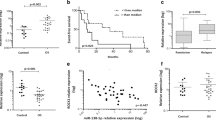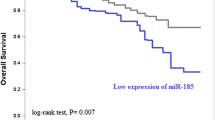Abstract
The sex-determining region Y-box 4 (SOX4), a transcription factor, is involved in various developmental processes. It has been reported in multiple human cancers. However, the prognostic value and its exact role in chondrosarcoma remain poorly understood. In the current study, SOX4 was overexpressed in 28 of 92 (30.4 %) interpretable chondrosarcoma patients compared with 3 of 43 (6.9 %) interpretable chondroma cases (P = 0.003). Its overexpression in chondrosarcoma was significantly associated with histological grade (P < 0.001) and the presence of tumor recurrence (P = 0.041). In addition, SOX4 overexpression was notably correlated with c-MYC (P = 0.011) and P53 (P = 0.029) expression as well as high Ki67 labeling index (LI) (P < 0.001) in our cohort. More importantly, we found that SOX4 was an unfavorable independent prognostic factor for chondrosarcoma patients with low histological grade. Functionally, SOX4 silencing significantly suppressed the proliferation, migratory, and invasive capacity of SW1353 cells, suggesting an oncogenic role of SOX4 in chondrosarcoma in vitro. In an attempt of characterizing SOX4 overexpression mechanism, we identified miR-30a as a tumor suppressor that directly targets SOX4 in chondrosarcoma cells. Clinically, miR-30a expression was negatively correlated with SOX4 expression in chondrosarcoma cases. In all, we identified that SOX4 was oncogenic in chondrosarcoma and negatively regulated by miR-30a in vitro. Importantly, SOX4 overexpression may serve as a prognostic marker for patients with low-histological-grade chondrosarcoma.






Similar content being viewed by others
References
Bovee JV, Hogendoorn PC, Wunder JS, Alman BA. Cartilage tumours and bone development: molecular pathology and possible therapeutic targets. Nat Rev Cancer. 2010;10:481–8.
van Oosterwijk JG, Anninga JK, Gelderblom H, Cleton-Jansen AM, Bovee JV. Update on targets and novel treatment options for high-grade osteosarcoma and chondrosarcoma. Hematol Oncol Clin North Am. 2013;27:1021–48.
Kamachi Y, Kondoh H. Sox proteins: regulators of cell fate specification and differentiation. Development. 2013;140:4129–44.
Akiyama H, Chaboissier MC, Martin JF, Schedl A, de Crombrugghe B. The transcription factor Sox9 has essential roles in successive steps of the chondrocyte differentiation pathway and is required for expression of Sox5 and Sox6. Genes Dev. 2002;16:2813–28.
Sekiya I, Vuoristo JT, Larson BL, Prockop DJ. In vitro cartilage formation by human adult stem cells from bone marrow stroma defines the sequence of cellular and molecular events during chondrogenesis. Proc Natl Acad Sci U S A. 2002;99:4397–402.
Reppe S, Rian E, Jemtland R, Olstad OK, Gautvik VT, Gautvik KM. Sox-4 messenger RNA is expressed in the embryonic growth plate and regulated via the parathyroid hormone/parathyroid hormone-related protein receptor in osteoblast-like cells. J Bone Miner Res. 2000;15:2402–12.
Jafarnejad SM, Ardekani GS, Ghaffari M, Li G. Pleiotropic function of SRY-related HMG box transcription factor 4 in regulation of tumorigenesis. Cell Mol Life Sci. 2013;70:2677–96.
Liao YL, Sun YM, Chau GY, Chau YP, Lai TC, Wang JL, et al. Identification of SOX4 target genes using phylogenetic footprinting-based prediction from expression microarrays suggests that overexpression of SOX4 potentiates metastasis in hepatocellular carcinoma. Oncogene. 2008;27:5578–89.
Aaboe M, Birkenkamp-Demtroder K, Wiuf C, Sorensen FB, Thykjaer T, Sauter G, et al. SOX4 expression in bladder carcinoma: clinical aspects and in vitro functional characterization. Cancer Res. 2006;66:3434–42.
Wang L, Zhang J, Yang X, Chang YW, Qi M, Zhou Z, et al. SOX4 is associated with poor prognosis in prostate cancer and promotes epithelial–mesenchymal transition in vitro. Prostate Cancer Prostatic Dis. 2013;16:301–7.
Scharer CD, McCabe CD, Ali-Seyed M, Berger MF, Bulyk ML, Moreno CS. Genome-wide promoter analysis of the SOX4 transcriptional network in prostate cancer cells. Cancer Res. 2009;69:709–17.
Reymann S, Borlak J. Transcription profiling of lung adenocarcinomas of c-myc-transgenic mice: identification of the c-myc regulatory gene network. BMC Syst Biol. 2008;2:46.
Morrison C, Radmacher M, Mohammed N, Suster D, Auer H, Jones S, et al. MYC amplification and polysomy 8 in chondrosarcoma: array comparative genomic hybridization, fluorescent in situ hybridization, and association with outcome. J Clin Oncol. 2005;23:9369–76.
Si X, Liu Z. Expression and significance of cell cycle-related proteins cyclin Dl, CDK4, p27, E2F-l and Ets-1 in chondrosarcoma of the jaws. Oral Oncol. 2001;37:431–6.
Kolupaeva V, Basilico C. Overexpression of cyclin E/CDK2 complexes overcomes FGF-induced cell cycle arrest in the presence of hypophosphorylated Rb proteins. Cell Cycle. 2012;11:2557–66.
Croce CM. Causes and consequences of microRNA dysregulation in cancer. Nat Rev Genet. 2009;10:704–14.
Ameres SL, Zamore PD. Diversifying microRNA sequence and function. Nat Rev Mol Cell Biol. 2013;14:475–88.
Tsukamoto O, Miura K, Mishima H, Abe S, Kaneuchi M, Higashijima A, et al. Identification of endometrioid endometrial carcinoma-associated microRNAs in tissue and plasma. Gynecol Oncol. 2014;132:715–21.
Henrici A, Montalbano R, Neureiter D, Krause M, Stiewe T, Slater EP, et al. The pan-deacetylase inhibitor panobinostat suppresses the expression of oncogenic miRNAs in hepatocellular carcinoma cell lines. Mol Carcinog. 2013
Yu Y, Cao L, Yang L, Kang R, Lotze M, Tang D. microRNA 30A promotes autophagy in response to cancer therapy. Autophagy. 2012;8:853–5.
Dyrskjot L, Ostenfeld MS, Bramsen JB, Silahtaroglu AN, Lamy P, Ramanathan R, et al. Genomic profiling of microRNAs in bladder cancer: miR-129 is associated with poor outcome and promotes cell death in vitro. Cancer Res. 2009;69:4851–60.
Tavazoie SF, Alarcon C, Oskarsson T, Padua D, Wang Q, Bos PD, et al. Endogenous human microRNAs that suppress breast cancer metastasis. Nature. 2008;451:147–52.
Liu S, Patel SH, Ginestier C, Ibarra I, Martin-Trevino R, Bai S, et al. MicroRNA93 regulates proliferation and differentiation of normal and malignant breast stem cells. PLoS Genet. 2012;8:e1002751.
Han B, Mehra R, Lonigro RJ, Wang L, Suleman K, Menon A, et al. Fluorescence in situ hybridization study shows association of PTEN deletion with ERG rearrangement during prostate cancer progression. Mod Pathol. 2009;22:1083–93.
Zhang J, Shen C, Wang L, Ma Q, Xia P, Qi M, et al. Metformin inhibits epithelial–mesenchymal transition in prostate cancer cells: involvement of the tumor suppressor miR30a and its target gene SOX4. Biochem Biophys Res Commun. 2014;452:746–52.
Wang C, Wang L, Su B, Lu N, Song J, Yang X, et al. Serine protease inhibitor Kazal type 1 promotes epithelial–mesenchymal transition through EGFR signaling pathway in prostate cancer. Prostate. 2014;74:689–701.
Nawa G, Ueda T, Mori S, Yoshikawa H, Fukuda H, Ishiguro S, et al. Prognostic significance of Ki67 (MIB1) proliferation index and p53 over-expression in chondrosarcomas. Int J Cancer. 1996;69:86–91.
Boeuf S, Kunz P, Hennig T, Lehner B, Hogendoorn P, Bovee J, et al. A chondrogenic gene expression signature in mesenchymal stem cells is a classifier of conventional central chondrosarcoma. J Pathol. 2008;216:158–66.
Pan X, Zhao J, Zhang WN, Li HY, Mu R, Zhou T, et al. Induction of SOX4 by DNA damage is critical for p53 stabilization and function. Proc Natl Acad Sci U S A. 2009;106:3788–93.
Hur W, Rhim H, Jung CK, Kim JD, Bae SH, Jang JW, et al. SOX4 overexpression regulates the p53-mediated apoptosis in hepatocellular carcinoma: clinical implication and functional analysis in vitro. Carcinogenesis. 2010;31:1298–307.
Eguchi T, Watanabe K, Hara ES, Ono M, Kuboki T, Calderwood SK. OstemiR: a novel panel of microRNA biomarkers in osteoblastic and osteocytic differentiation from mesencymal stem cells. PLoS One. 2013;8:e58796.
Acknowledgments
This work was supported by the National Natural Science Foundation of China (Grant No. 81302239), National Natural Science Foundation of Shandong Province (Grant No. ZR2013HM094), Promotive Research Fund for Excellent Young and Middle-Aged Scientists of Shandong Province (Grant No. BS2012YY020), Science Foundation of Shandong Province China (Grant No. ZR2011HQ040), and Independent Innovation Foundation of Shandong University (Grant No. 2012TS121).
Conflicts of interest
None
Author information
Authors and Affiliations
Corresponding authors
Electronic supplementary material
Below is the link to the electronic supplementary material.
Supplementary Fig. 1
Comparison of SOX4 IHC staining between chondrosarcoma and chondroma, ×400. (a) Representative IHC image of SOX4 in chondroma. (b) Representative IHC image of SOX4 in chondrosarcoma (GIF 150 kb)
ESM 2
(DOC 37 kb)
ESM 3
(DOC 34 kb)
Rights and permissions
About this article
Cite this article
Lu, N., Lin, T., Wang, L. et al. Association of SOX4 regulated by tumor suppressor miR-30a with poor prognosis in low-grade chondrosarcoma. Tumor Biol. 36, 3843–3852 (2015). https://doi.org/10.1007/s13277-014-3026-2
Received:
Accepted:
Published:
Issue Date:
DOI: https://doi.org/10.1007/s13277-014-3026-2




